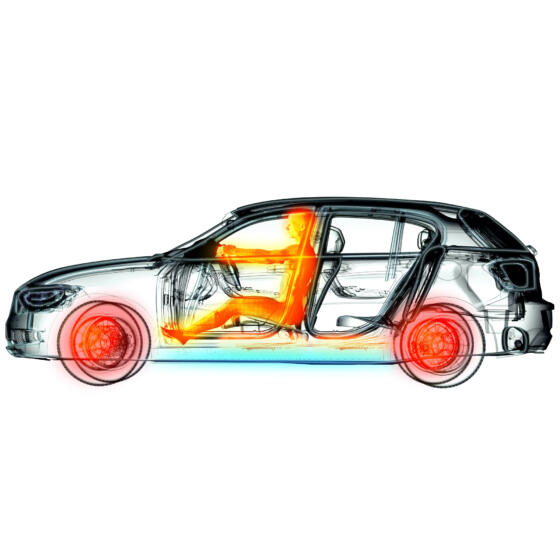Increasingly attractive without magnets
The differences between permanently and externally excited
The functional principle of an electric motor is based on magnetic forces of attraction and repulsion converting electric power into mechanical (rotary) motion. Currently, 88 percent of all electric drive systems in the passenger car & light truck segments are using permanent magnet synchronous motors (PMSMs). Installed in their rotating core (rotor) is a permanent magnet interacting with a magnetic field that’s electrically generated by a copper winding in the stator. Its advantages are proven technology, high efficiency, and compact design. A major disadvantage is the fact that permanent magnets require rare earth elements (REEs) that are environmentally and economically critical (see info box). That’s why externally excited synchronous motors (EESMs), whose current market share is around five percent, are increasingly moving into the focus of development engineers. There, the permanent magnet in the rotor is replaced by a copper-wrapped iron core that, like the stator, generates a magnetic field by means of current flow.
Why are rare earth elements not rare – and are no earths?
The term has its origins in the 19th century when these elements were isolated from rare minerals for the first time. Back then it was thought that they were earth-like substances (i.e., oxides) because they existed in the form of powders – similar to clay or soil, but chemically they’re metals and many of these supposedly “rare” elements exist more frequently in the Earth’s crust than gold, platinum, or other metals. The rare earth cerium, for example, is found more frequently than copper and neodymium that’s needed for magnets is more common than lead. However, REEs aren’t found in deposits in large concentrations but are typically dispersed in other minerals. That makes mining and separating them a complex and costly process which poses a major burden to the environment due to the massive use of energy and chemicals plus the radioactive byproducts incurred. That China is controlling 80 percent of the worldwide mining and production of REEs is not only because that’s where the largest deposits are located but also because the country began exploring the production of REEs at an early stage and has continually been extending its capacities in that area.

“We offer a particularly sustainable option to our customers. The higher the required performance class of the drive systems, the more economical benefit is gained by the EESM technology.”
What general conditions have changed so that EESMs are becoming increasingly attractive alternatives?
On the one hand, rare earth elements like neodymium (Nd) and praseodymium (Pr) for PMSMs are increasingly hard to predict especially in terms of price development and availability. Moreover, the use of REEs clearly drives up the so-called global warming potential of electric powertrains. REEs have a negative impact on other sustainability criteria as well. On the other hand, the automotive industry has made major progress in terms of electric vehicle range so that the user profile is extending toward long-distance travel. As a result, electric motors operate more frequently and for longer periods at high rotational speeds. In addition, more powerful batteries make it possible to pull trailers. In a nutshell, the improved usability of electric cars extends the requirements profile of electric motors as well. The magnetization of a PMSM is optimized for a defined operating window. So far, the primary objective in most cases has been to offer the driver torque and power output in the lower speed range. At higher rotational speeds and power output, a PMSM that has been optimized in that way no longer operates with highest efficiency. In the case of an EESM, magnetization – because it can be controlled via the current flow – can be adjusted to suit various requirement profiles using appropriate control electronics and a nearly constant power output can be achieved across a wide rotational speed range. In total, the aforementioned developments have resulted in a reassessment of magnet-free electric motors.

What technical measures do Schaeffler’s experts use to eliminate design-related deficits of the EESM versus the PMSM or even turn them into advantages?
So far, the major advantage of the EESM, i.e., of not requiring critical rare earth elements, has been contrasted by disadvantages such as larger design space and higher costs compared to the PMSM. If Schaeffler’s engineers, as expected, manage to make the EESM a more compact unit by optimizing the rotor it would enable not only downsizing the design space (which, among other things, is required for the brush system transmitting the excitation current) and reducing weight but also cutting material costs by 8 to 12 percent. As a result, the two motor concepts would be nearly equal. Especially in the case of higher-performance vehicles, the EESM might even offer cost benefits compared to an PMSM because the more power is needed the larger the magnets of the latter would have to be and the more rare earth elements would need to be installed. The break even might be as low as 120 kW, depending on raw material prices. To nearly equal the design space level of the PMSM ( plus 30 to 40 mm/ 1.2– to 1.5 in) Schaeffler’s experts are pursuing a better integration of the brush system and have come up with yet another idea: they want to use the space created around the brushes for a rotor lock that could replace a parking lock mechanism in the transmission, thus creating space there.

What performance and efficiency advantages does an EESM have over a PMSM?
While the performance curve of a PMSM drops below the maximum level at high rotational speeds it remains at a high level at top rotational speed in the case of the EESM (see infographic). Here, the EESM has a significant efficiency advantage making it clearly more suitable especially for long-distance travel.

Why did Schaeffler’s engineers opt for a brush system to supply the – partly very fast-turning – rotor in the EESM with excitation current?
Basically, there are two ways to transmit the excitation current to the rotating shaft: contactless due to inductive injection or conductively using brush contacts with slip rings on the shaft. Based on practical experience and data analyses from real-world operations in field tests performed since 2010, Schaefffler opted for an optimized brush system. Wear and robustness of the brushes were validated in endurance tests due to optimized material pairing, contact force, and other parameters for the required service life (300,000 km/186,000 mi/15 years). Moreover, a brush system can transmit a short-term higher excitation current for boost operation while an inductive system only allows the defined maximum current to flow. In addition, in the case of increasing excitation currents, the brush system has an efficiency advantage. A sophisticated brush system has the benefit of eliminating a considerable amount of complexity (no rotating transformer, no rotating rectifier) and therefore costs from the EESM drive.

What’s the market potential of externally excited electric motors?
Just because of the technical advantages in the growing higher performance sector, EESM drives could increase their current market share of around 5 percent to 8 percent in 2030, according to forecasts by Schaeffler’s experts. Should the situation around rare earth elements (prices, availability, etc.) significantly deteriorate an increase to as much as 40 percent would be possible. To be prepared for any contingency, Schaeffler is aiming to develop axle drive platforms in ways enabling either PMSM or EESM rotors as plug-and-play solutions according to the customer’s wishes.


